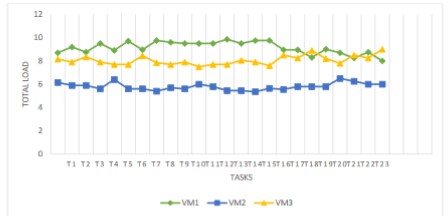Development of Load Balancing Methodology in Cloud Computing Platforms
Keywords:
cloud computing, load balancing, task scheduling, probability theory, resources allocationAbstract
Load balancing is the process of distributing customer tasks among multiple computing resources, such as virtual machines (VMs), servers and networks. It is a major concern in cloud computing as the number of customer demanding the service is growing exponentially. An efficient load balancing approach can detect the load of the VMs proactively and assigns the customer tasks to the VMs accordingly. In this paper, we present a mechanism on load balancing in cloud using probability theory. The main aim of the proposed approach is to reduce the standard deviation of the load between the virtual machines so that they are close to zero.
Downloads
References
Rashid, A., & Chaturvedi, A. (2019). Cloud computing characteristics and services: a brief review. International Journal of Computer Sciences and Engineering, 7(2), 421-426.
Singh, P., Dutta, M., & Aggarwal, N. (2017). A review of task scheduling based on meta-heuristics approach in cloud computing. Knowledge and Information Systems, 52(1), 1-51.
Panda, S. K., & Jana, P. K. (2018). Normalization-based task scheduling algorithms for heterogeneous multi-cloud environment. Information Systems Frontiers, 20(2), 373-399.
Chalack, V. A., Razavi, S. N., & Gudakahriz, S. J. (2017). Resource allocation in cloud environment using approaches based particle swarm optimization. International Journal of Computer Applications Technology and Research, 6(2), 87-90.
Gao, R., & Wu, J. (2015). Dynamic load balancing strategy for cloud computing with ant colony optimization. Future Internet, 7(4), 465-483.
Dhari, A., & Arif, K. I. (2017). An efficient load balancing scheme for cloud computing. Indian Journal of Science and Technology, 10(11), 1-8.
Phi, N. X., Tin, C. T., Thu, L. N. K., & Hung, T. C. (2018). Proposed load balancing algorithm to reduce response time and processing time on cloud computing. Int. J. Comput. Netw. Commun, 10(3), 87-98.
Chien, N. K., Son, N. H., & Loc, H. D. (2016, January). Load balancing algorithm based on estimating finish time of services in cloud computing. In 2016 18th International Conference on Advanced Communication Technology (ICACT) (pp. 228-233). IEEE.
Stephen, A., Shanthan, B. H., & Ravindran, D. (2018). Enhanced round Robin algorithm for cloud computing. Int J Sci Res Comput Sci Appl Manag Stud, 7(4), 1-5.
Rashid, A., & Chaturvedi, A. (2019). Cloud computing characteristics and services: a brief review. International Journal of Computer Sciences and Engineering, 7(2), 421-426.
Singh, P., Dutta, M., & Aggarwal, N. (2017). A review of task scheduling based on meta-heuristics approach in cloud computing. Knowledge and Information Systems, 52(1), 1-51.
Panda, S. K., & Jana, P. K. (2018). Normalization-based task scheduling algorithms for heterogeneous multi-cloud environment. Information Systems Frontiers, 20(2), 373-399.
Leys, C., Ley, C., Klein, O., Bernard, P., & Licata, L. (2013). Detecting outliers: Do not use standard deviation around the mean, use absolute deviation around the median. Journal of Experimental Social Psychology, 49(4), 764-766.

Downloads
Published
How to Cite
Issue
Section
License

This work is licensed under a Creative Commons Attribution-ShareAlike 4.0 International License.
All papers should be submitted electronically. All submitted manuscripts must be original work that is not under submission at another journal or under consideration for publication in another form, such as a monograph or chapter of a book. Authors of submitted papers are obligated not to submit their paper for publication elsewhere until an editorial decision is rendered on their submission. Further, authors of accepted papers are prohibited from publishing the results in other publications that appear before the paper is published in the Journal unless they receive approval for doing so from the Editor-In-Chief.
IJISAE open access articles are licensed under a Creative Commons Attribution-ShareAlike 4.0 International License. This license lets the audience to give appropriate credit, provide a link to the license, and indicate if changes were made and if they remix, transform, or build upon the material, they must distribute contributions under the same license as the original.





